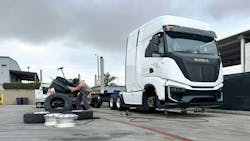Timeline of Nikola's rise and fall
- 2014: Nikola Motor Company founded by Trevor Milton
- Jan. 2018: Nikola posts infamous video of Nikola One fuel-cell electric truck rolling down highway
- 2019: Nikola demonstrates the Nikola Two fuel-cell electric truck
- June 2020: Nikola goes public by merging with SPAC
- Sept. 8, 2020 - Nikola announces plan to partner with General Motors for fuel cells and hydrogen-powered pickup called the Badger.
- Sept. 10, 2020 - Hindenburg Research accuses Nikola founder Trevor Milton of fraud.
- Nov. 2020 - GM and Nikola renegotiate, dooming fuel cell pickup truck
- Oct. 2022 - Nikola founder Trevor Milton convicted of fraud
- July 31 2023 - Nikola began to produce its fuel-cell electric vehicles
- Aug. 2023 - Nikola recalls 209 Tre BEVs over battery coolant leak
- Dec. 2023: Nikola delivers first Nikola FCEVs to customers
- July 2024 - The Nikola Tre FCEV passes 1 million total miles driven.
- Nov. 2024 - Nikola Q3 results indicate OEM might not have enough cash to get past Q1 2025.
Being possible and being profitable are two very different things, as proven by Nikola, the first OEM to market with a Class 8 fuel cell electric vehicle. The Phoenix-based company filed for Chapter 11 bankruptcy on Feb. 19 and plans to auction and sell its assets. Nikola reported in the filing that $47 million of cash on hand is left to fund limited operations.
These include meeting obligations to employees, providing continuing service and support for current Nikola BEV and FCEVs customers, and operating certain HYLA hydrogen fueling stations, all through March 2025.
The bankruptcy was foreshadowed in Nikola’s last 2024 earnings call, where the company acknowledged it did not have enough money to get past Q1 2025 without new investments.
“Like other companies in the electric vehicle industry, we have faced various market and macroeconomic factors that have impacted our ability to operate,” Nikola CEO Steve Girsky stated in a release announcing the bankruptcy. “In recent months, we have taken numerous actions to raise capital, reduce our liabilities, clean up our balance sheet, and preserve cash to sustain our operations. Unfortunately, our very best efforts have not been enough to overcome these significant challenges, and the Board has determined that Chapter 11 represents the best possible path forward under the circumstances for the Company and its stakeholders.”
Shortly after Girsky took over in 2023, he claimed Nikola was on a “path to profitability by the end of 2025” and that “we're not planning on stopping anytime soon.” There is a pathway for Nikola to sell off certain assets—it already sold its Romeo Power battery assets to Mullen Automotive—and somehow reorganize. The chances of either the Nikola name or its leadership staying in place are unlikely.
What happened?
If you’ve followed Nikola’s tumultuous journey to this point, you’re familiar with why. The company has never been able to remove the dark mark left by founder Trevor Milton, whose years of dubious moves landed him four years in prison for fraud and deceiving investors.
Nikola also issued a total recall of all 209 BEVs due to fire risk in 2023, with one fire destroying five Nikola BEVs at its Phoenix headquarters in June of that year. A battery pack coolant leak was deemed the culprit and as of this month, only 40 had been fixed.
As the first production-scale fuel cell truck in North America, the Nikola FCEV was also not without problems. One of the company’s biggest proponents, William Hall, owner of Coyote Container, noted in his first year of ownership, that technology and maintenance issues, such as a recurring valve issue, led to “lots of downtime.”
Hall, a drayage trucker, bought the FCEV as an experiment to see if hydrogen could be a feasible zero-emission solution at California ports. He delivered loads between the Ports of Oakland and Los Angeles.
He had targeted 50,000 miles for 2024 but told Fleet Maintenance on Dec. 13, 2024, that he was at 32,000 miles. Hall also said at the time he “submitted a complaint to NHTSA due to the repeated fuel cell shutdowns that have left me roadside and resulted in three towing events all due to the same defect.”
When asked at the time what a Nikola bankruptcy could mean to him, he wrote:
“Service and fuel supply would be a show stopper if Nikola were to cease operations. Without Nikola Pulse support, the truck would eventually cease to function.”
He added his “truck breaks down all the time for a variety of reasons including the persistent issue of the ‘Tank Valve Failure.’”
Now, with the likely end of Nikola here, Hall had a more bittersweet, wistful tone. At times he was frustrated with Nikola's leadership, yet always positive about the technology’s potential. He was the best kind of friend for Nikola—someone loyal but not afraid to speak their mind when the company fell short.
“It is a sad day for the zero-emissions movement that is committed to moving away from fossil fuels,” he told Fleet Maintenance shortly after the bankruptcy was announced. “There was a strong backbone formed out of the Nikola product line and early adopters.”
He also is holding out hope some version of the company could survive.
“I can see this continuing to move forward,” Hall said. “With good fortune, Nikola will rise from the ashes like a phoenix and return to serving a market that was just in its infancy. Chapter 11 is a reorganization process. I was out in my Nikola truck yesterday and will jump behind the wheel again today. They are shipping me some warranty parts and I need a new windshield.”
Nikola’s notable achievements
Girsky, the former Nikola chairman who took on the role just as the FCEV began production in the summer of 2023, noted what the OEM accomplished was a net positive for the clean trucking movement.
“With the dedication of our employees and support from our partners, Nikola has taken significant steps to move zero-emissions transportation forward, including bringing the first commercially available Class 8 hydrogen fuel cell electric trucks to market in North America and developing the HYLA hydrogen refueling highway, connecting Northern California to Southern California,” Girsky said.
He also cited that the Nikola fleet customers surpassed 3.3 million miles driving the BEV and FCEV models and that the HYLA stations dispensed more than 330 metric tons of hydrogen.
Customers included JB Hunt, which started with three FCEVs and purchased 20 more last fall, and Biagi Brothers, which reportedly received 15 of the first FCEVs produced at the end of 2023.
Even with tax incentives, both companies have sunk many millions into the FCEVs. Whether they will get the support they need in April to continue using the FCEVs—and generating enough revenue to justify the investment—is as of now unknown.
A direct question as to what will become of Nikola customers was met with a copy-paste of a press release passage:
“Subject to Court approval, the Company intends to continue certain limited directly provided (non-dealer) service and support operations for trucks currently in the field, including certain HYLA fueling operations through the end of March 2025. Thereafter, the Company will need one or more partners to support such activities.”
In response, Fleet Maintenance asked: Should we infer that if no such partner is found, these folks are essentially out the cost of the truck? There's a recurring valve issue on at least one owner's truck that has left his FCEV down for extended periods. Does Nikola intend to help people like this recoup investment in any scenario?
We have not received a reply as of yet but will be sure to provide an update if they do.
Ahead of its time?
The FCEV features a range of up to 500 miles per fill-up and was celebrated for proving hydrogen could become a clean alternative to fossil fuels. The problem has always been the high cost of hydrogen, especially the truly “green” kind made from renewable sources like hydro or solar power. In California last October, a kilogram of retail hydrogen was over $34 due to supply disruptions, according to S&P Global. The U.S. Department of Energy is working toward bringing the production cost of clean hydrogen down to $1/kg by 2031, but that is six years away. And Nikola appears out of time and money.
It's not the only casualty of hydrogen’s immature supply chain.
Hyzon Motors, a competitor in the hydrogen transportation space, began its dissolution process before last Christmas and is reportedly searching for a company to buy its assets. While Nikola built its trucks in Coolidge, Arizona using a cabover design borrowed from Iveco, Hyzon placed fuel-cell technology on existing Class 8 semis and refuse trucks.
Global leaders in trucking, such as Daimler Tuck, Paccar, and Volvo have had a more methodical approach. Daimler, which has a joint venture with Volvo to develop fuel cells, isn’t planning a production-ready FCEV until around 2030. Hyundai, which also has hydrogen-powered passenger vehicles, is running smaller-scale deliveries between its Georgia manufacturing sites with its Xcient Class 8 fuel cell truck. The Korean-based auto- and truck maker has nearly 50 Xcients in Switzerland, which as of June 2024 accrued 621,000 miles (10 million km). The project started in 2020.
The Trump factor
The Advanced Clean Fleets regulations decreed by California Gov. Gavin Newsome and the California Air Resources Board would have forced truck operators in the state to adopt zero-emission vehicles; the EPA waiver that would have allowed the environmental authoritarianism was rescinded when President Donald Trump began his second term. Trump had promised to end “electric vehicle mandates” and has put in place cabinet members, such as EPA Administrator Lee Zeldin and Secretary of Transportation Sean Duffy, to ensure climate agendas were not prioritized for U.S. economic health. To that end, federal money streaming to zero-emission projects—via laws passed during the Biden era—has been dammed up for the time being. That in turn has slowed investments in clean technology.
The New York Times reported Nel, a manufacturer of electrolyzers used to produce hydrogen, is not going forward with building its planned Michigan gigafactory, due to uncertainty around tax credits.
“It’s not down to one single thing — there’s just too much uncertainty, and that prevents boards and steering committees from approving business cases,” Nel CEO Hakon Volldal told the paper of record.
Plug Power, a green hydrogen producer based in New York has faced similar challenges and has missed revenue estimates.
None of this means hydrogen will never be a suitable form of fuel, though by the time it does, the question is how much more advanced battery technology will be. If they have range parity, what fleet would want to deal with the cost, as well as the maintenance and technology issues, of fuel cells and hydrogen storage?
About the Author

John Hitch
Editor-in-chief, Fleet Maintenance
John Hitch is the award-winning editor-in-chief of Fleet Maintenance, where his mission is to provide maintenance leaders and technicians with the the latest information on tools, strategies, and best practices to keep their fleets' commercial vehicles moving.
He is based out of Cleveland, Ohio, and has worked in the B2B journalism space for more than a decade. Hitch was previously senior editor for FleetOwner and before that was technology editor for IndustryWeek and and managing editor of New Equipment Digest.
Hitch graduated from Kent State University and was editor of the student magazine The Burr in 2009.
The former sonar technician served honorably aboard the fast-attack submarine USS Oklahoma City (SSN-723), where he participated in counter-drug ops, an under-ice expedition, and other missions he's not allowed to talk about for several more decades.

